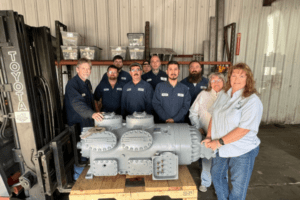
CPR valves play an important role in protecting your refrigeration equipment. If you are not familiar with CPR valves and how they work with your commercial compressor, this guide will help you understand more about this component. It is important to note that not all systems use a CPR valve, so you may have to inspect your system to determine whether or not this component is in place.
What is the CPR Valve?
CPR is an abbreviation for Crankcase Pressure Regulator. This is a mechanical valve that is installed just after the crankcase where it can measure the true output pressure of your crankcase in a refrigeration system. It is not to be confused with the EPR valve which is installed after the Evaporator, although the two regulators look very similar and serve a similar purpose. On one side of the regulator will be the pressure buildup of the refrigerant. As the pressure increases, it will push the flap closed and hold it there until the pressure has started to fall. A spring mechanism will slowly allow the flap to open once the outlet pressure has dropped back to a normal level, allowing the continued flow of refrigerant to the system.
Why You Need a CPR Valve for Your Commercial Compressor
Commercial refrigeration systems, in particular, have a need for CPR and EPR valves. This is especially true of full-size walk-in units where doors may be opened and closed at random. Each time this happens, the carefully controlled air temperature inside your refrigerator fluctuates, sometimes interrupting your unit’s natural cooling cycle. On occasion, this disruption occurs during a defrost period, and your compressor reacts by trying to jump-start the system. This will increase the crankcase pressure above where it should be and could cause damage to other components in your system. The CPR valve prevents this by fluctuating the size of the output port opening in response to pressure changes, thus your temperature and pressure remain stable throughout the rest of your system.
Adjusting Your CPR Valve
Another important aspect of the CPR valve for your commercial compressor is the ability to adjust it as needed. Most CPR valves are standardized to fit common suction line sizes, but that does not necessarily mean that they are all the same. In fact, you can choose from a wide range of flow capacity ratings depending on the type and size of the compressor you are using. It is important that you match your CPR valve to your intended use so you don’t unintentionally limit your output or allow for too high of a pressure. Once your CPR valve is in place, you can fine tune it by adjusting it to the exact needs of your refrigeration unit by changing the spring tension. An experienced technician can perform this adjustment and test your system for optimal performance using a set of gauges and test equipment. The spring can be adjusted by turning a screw, and many CPR valves feature a testing port on the side for easy adjusting.
CPR valves are important in many commercial refrigeration and HVAC systems where system disruptions are common. These valves allow the compressor to complete its normal shut down or defrost cycles without causing an unwanted buildup of pressure. These components are installed in-line with your crankcase before the evaporator, and ultimately help preserve the life of your other system components. If you are unsure about the state of your CPR valve, make sure to contact your local commercial refrigeration supply house and they can help you track down the right size and type of valve for your needs. They can also help identify any signs that your valve may be going bad. If you have problems with the compressor, please contact Compressors Unlimited for a replacement.












